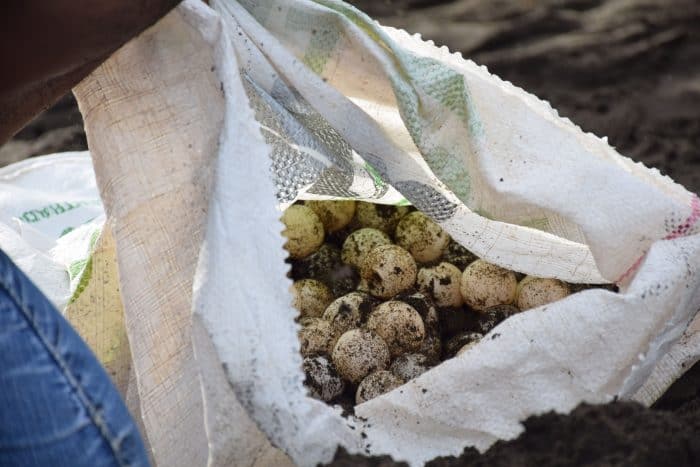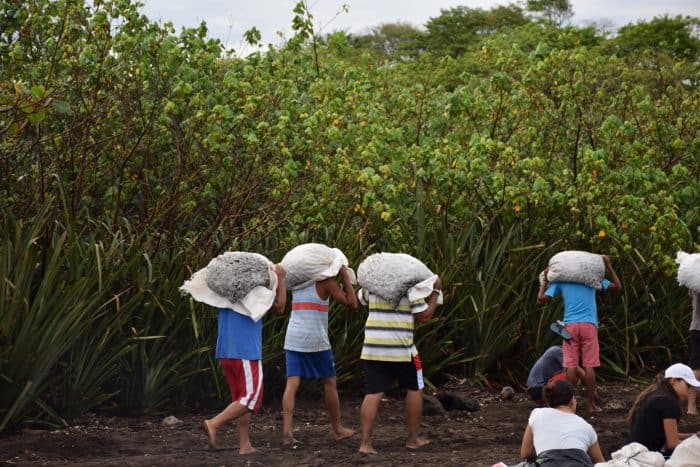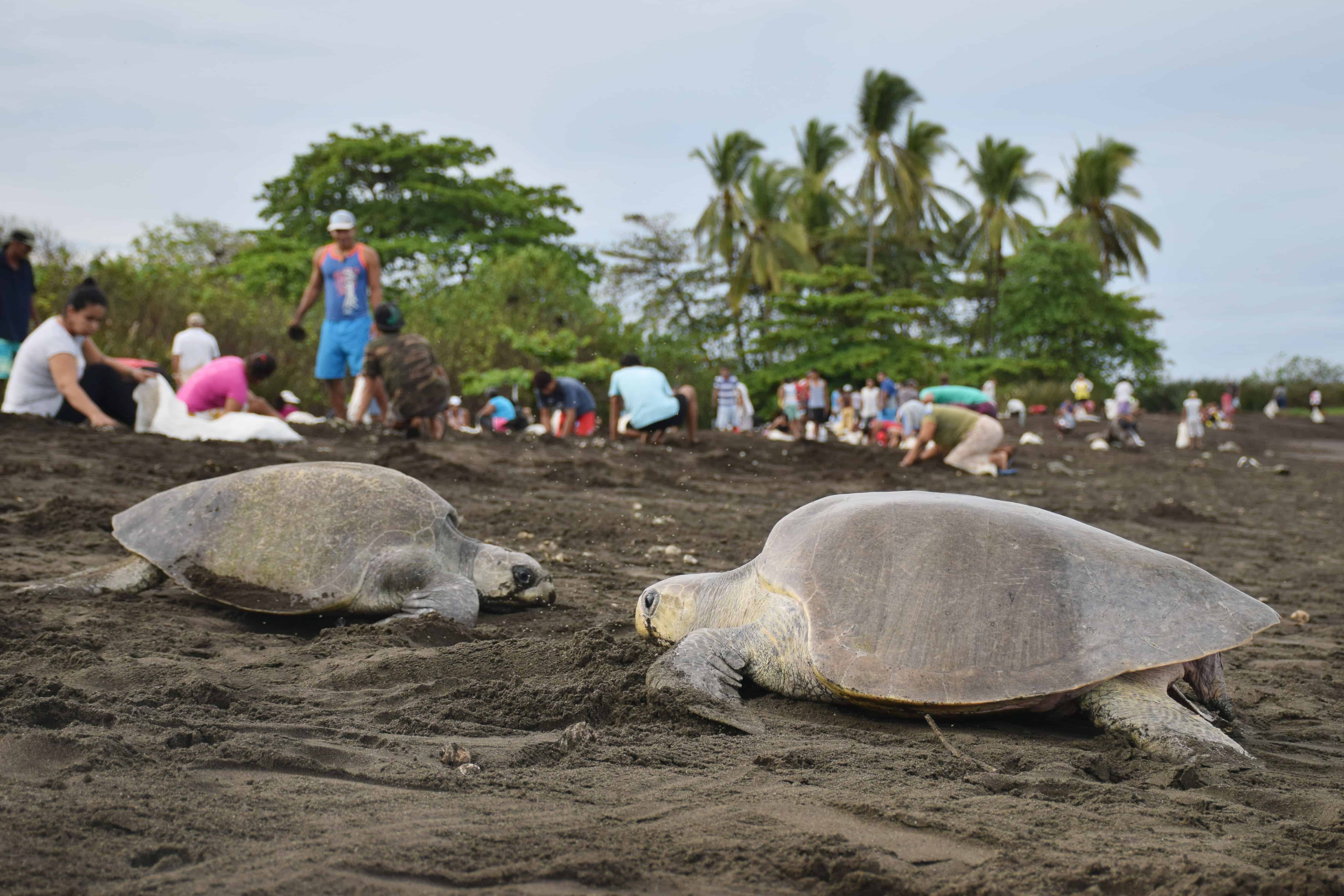Sea foam laps the shore as the sun rises over the ocean. It’s 5 a.m. on a calm, beautiful morning, but the residents of Ostional aren’t out to enjoy a leisurely walk on the beach – they’re hard at work.
Men carefully dig in the sand with their toes and heels for signs of olive ridley sea turtle nests. Women dig in the sand with their hands, collecting the Ping-Pong ball-sized eggs in large white sacks that the men heave away on their shoulders to be counted, cleaned and distributed among the villagers for sale and consumption.
A few olive ridley turtles (Lepidochelys olivacea) make their laborious crawl up the beach to lay their eggs. These are the solitary stragglers left over from the previous night’s “arribada,” which is Spanish for “arrival.” During an arribada, thousands of olive ridleys come to Ostional to lay their eggs. Ostional is one of only a handful of sea turtle nesting sights in the world, and the only place where it is legal for people to harvest the eggs under a plan intended to give both the residents and turtles of Ostional a better chance of survival.
This small, remote town of 700, sandwiched between the Ostional Wildlife Reserve and the shores of the Pacific Ocean on the Nicoya Peninsula, is reachable only via a long, dirt road filled with potholes and often flooded by tropical rains. Children play on a football field in the town’s center, and groups of people often can be seen riding around, some sharing the same moped or bicycle. Stray dogs roam the streets, greeting strangers with wagging tails.
Weathered homes of plywood, tin or concrete are scattered along the main road through town, with red-and-white satellite dishes connecting residents to the outside world. A sign on the main road reminds residents that a doctor from nearby Santa Cruz will visit each Monday to see patients. Ranchers watch over small plots of land and cattle growing thin from ongoing drought in the northwestern province, another threat to economic and physical survival in the region.
Despite the hardships, Ostional has become famous as a nesting site for olive ridley sea turtles, attracting tourists and volunteers from all over the world.

The turtles in Ostional
Olive ridleys, known in Spanish as la tortuga lora, have come to the shores of Ostional to lay their eggs since at least the 1930s, when 82-year-old town elder Basilio Vega Figueroa settled here. However, starting in 1959, huge arribadas began to arrive every month. From the beginning, Vega said, eating turtle eggs was a normal part of life in Ostional.
However, declining sea turtle populations worldwide put increased pressure on Costa Rica to stop sea turtle egg poaching. In 1966, it became illegal to buy, sell or eat sea turtle eggs throughout the country. For residents of Ostional, that was a major blow to the economy and the food supply. The small, rural village depended on the eggs as a source of protein and income, especially during the winter, when high rainfall left the town cut off from the rest of the country.
Life in Ostional has always been difficult, and losing eggs as a food source only made things worse. This challenge, combined with the accidental killing of a townswoman, Concepción Oquendo, by police guarding the beach in 1980, and the continued destruction of turtle eggs by poachers and animals, led village leaders to come up with a compromise for turtle eggs, according to long time resident Tomás Chavarría.
“We have to manage rationally,” Chavarría said. In Ostional, that meant finding a balance between conservation and economic survival.
Symbiosis
Chavarría, along with Vega and other village elders, formed an organization called the Asociación de Desarrollo Integral de Ostional (ADIO) in 1984. They created a plan with the help of researchers from the University of Costa Rica and conservationists that would allow townspeople to collect eggs from one section of the beach in Ostional during the first 36 hours of an arribada. The eggs would then be divided among the townspeople to eat and sell.
To some, this compromise makes Ostional a pillar of hope for sustainable conservation with community support; however, some conservationists see it as a pretext that allows the continued human exploitation of marine animals. For the residents of Ostional, who consider themselves conservationists and call those opposed to ADIO “radical,” it is life.
“Conservationists, they attack us, literally,” said Wendy Cruz, director of Estación Biomarina Arribadas Ostional, a hostel and educational program for visitors to the town. “They attack us with words.”
She said the community, with the help of researchers from the University of Costa Rica, has shown that the program has actually increased the number of turtles that survive to hatch in Ostional due to decreased threat of disease and disruption among nests that are not harvested.
“The project isn’t only taking eggs from the nests,” said Hellen Lobo, a tropical conservation biologist who works for the Costa Rican Environment Ministry and ADIO. The community stalwartly works to protect the eggs and hatched turtles from other threats at the beach, including dogs, vultures and poachers, all of which helps the turtles survive, according to Lobo.

Living in Ostional Costa Rica
Even with ADIO, life in Ostional is difficult. There is little economic opportunity in the town and many young people must look elsewhere for work, explained ADIO guide Lisseth Vega Figueroa. She is currently studying criminology in the larger city of Santa Cruz, but returns to help with tours and collecting eggs when she can.
“To have a profession, you have to leave here, because there is almost nowhere to work,” she said. Though she’d like to stay in Ostional, Lisseth Vega will go to where she can find a job after graduating. Many of her peers are the same.
“The coastal cities are the poorest in the country,” said Mario Boza, a conservationist at Costa Rica’s National University. He said benefits of the project are supported by scientific research, although he is concerned that a lack of regulation for Ostional turtle eggs gives poachers an excuse to sell non-approved eggs as well. Despite problems, however, he recognizes the need for economic stability in the town.
Although Ostional is part of the Nicoya canton, which ranks 41st out of 81 cantons in Costa Rica in terms of human development, according to the United Nations Development Program, the reality in the town looks much different. In the region there is a distinct contrast between rural towns like Ostional and wealthy, often foreign communities such as Nosara, just a 30-minute drive up the coast. The poverty in Ostional becomes even more apparent juxtaposed with the large houses and boutique shopping in other parts of the peninsula.
Harvesting the olive ridley eggs can help families subsist, but growth and development are essentially out of the question. Though the town celebrated its centennial year in 2002, Ostional is not actually owned by the people who live there. Since 1984, when Ostional became a nature reserve, the government effectively took ownership of the land, enabling it to decide who can build, where and why, explained Cruz. That makes increasing the tourism industry challenging, as does the town’s remote location.
“We’d like to see more people coming here,” said Basilio Vega Figueroa. But with no easy way in and out, transporting goods and people is a challenge. Tourists come to see the turtles, but the community would like to see more people stay in the town, Basilio Vega said. He hopes tourism can help people in the town live better and provide more opportunities for young people.
“We are poor people,” he said. “But life here is better.”
Despite hardships, threats of coastal zoning laws and criticism by other conservationists, Ostional is a picturesque and idyllic combination of lush rain forest and sandy beaches. What Ostional lacks in material things it seems to make up in unity and natural beauty.
“We don’t have much, but we have love. It’s like a big family,” Basilio Vega said.
In Ostional, the turtles are like a member of the family too, added Lobo. The residents of Ostional know that their survival is linked to the fate of the turtles.
Kendal Blust is a master’s student in journalism at the University of Arizona.








